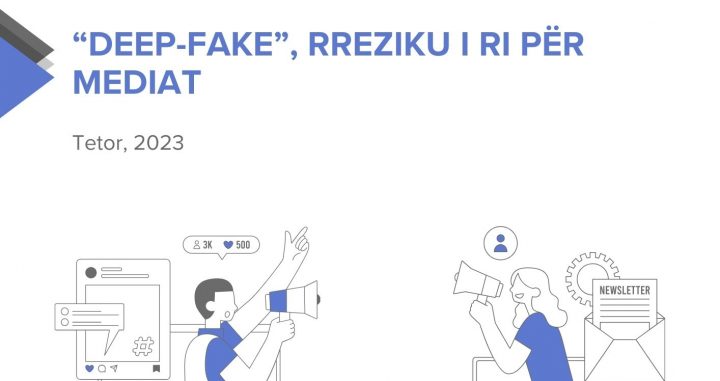
The rapid development of technology in general and in artificial intelligence in particular has inevitably influenced journalism in recent years. Monitoring of the media during the month of October 2023 showed that some media published content without verifying the source of information, while some others created uncertainty among citizens by quoting non-credible persons on certain topics.
Several videos of public figures, such as the Prime Minister of Kosovo, Albin Kurti Kinse, giving an interview in Arabic circulated on social networks. Many citizens believed the video, which was produced with the help of artificial intelligence, superimposing the voice in another language and even adapting the color of the voice to that of the person appearing in the video. This form of video is known as “Deep-Fake”.
Interactions on the social network “Tik-Tok” showed that Kuti’s video received 5625 likes, 483 comments and 2183 shares. It was also saved by the users of this social network a total of 2183 times.
This data speak volumes about the possibility of manipulation that can be done to public opinion by publishing a video that is actually fake. The Prime Minister of Kosovo does not speak Arabic, but many of the commenters on the video believed him.
During the past months, similar videos were published for the Albanian Prime Minister, Edi Rama, but also for other world leaders such as the American President, Joe Biden, speaking in Arabic and other languages.
“Deep-Fake” is now a new risk for the media, not only in Kosovo, but all over the world. As theories on “Deep-Fake” explain, verifying this kind of content is difficult – artificial intelligence made these videos seem so real that even the best professionals in the field often fall prey to them. However, advanced programs to detect “Deep-Fakes” have also been developed.
But, during the month of October, this form of disinformation was not the only one. The monitoring of media by civil society in the country recorded news whose sources of information were persons who are presented in the public eye as conspirators. So the media produces news on certain events in the country, including the events in the north of the country by quoting a conspiracy theorist.
This model of journalism, quoting a conspiracy theorist, is the worst model that can happen in the Kosovar media. Every theory taught in journalism schools suggests that the media should use credible, official and professional sources. The opposite happens in some media in Kosovo, quoting a person who calls himself a conspiracist, and at the same time seriously weakening the trust of the readers in the media.
The online media, and television programs, as well, should urgently avoid citing such persons, especially for events such as security ones, which can create uncertainty among citizens and arouse fear.
Nowadays, fact-checking for journalists is the main challenge. Abundant information is published everywhere on social networks, which will be hard to ever stop completely. It is important that serious media work more on verifying information before deciding to publish it.
During the month of October, a news story which was initially mistranslated by the official translation of the Prime Minister’s Office in Albania, gained ground. French President Emmanuel Macron during a conference spoke about visas for Kosovo, but he did not say that Kosovo will be subject to visa requirements. Media monitoring showed that 38 Albanian-language media published the news without verifying it. After that, there were many reactions in the political scene, in Kosovo, Albania and Serbia. But, only after carefully listening to Macron’s speech, it was seen that he had not talked about conditions in the visa liberalization process for Kosovo.
This is another case where the media can misinform the public opinion in the country and in the region. Such news, which are published to “catch” the first clicks, damage the reputation of the media. The media erred by prioritizing speed over accuracy. In order for the media to report correctly, fairly and impartially, it is necessary to apply the basic standards of journalism, which include accuracy and relevancy.
In order for the media to fulfill its mission, which is first and foremost to inform the public correctly, it must take care to use the source of information correctly. The media must verify the information before publishing it. By doing this, they fight the disinformation that circulates everywhere on the Internet.
On the other hand, an immediate action needed to be taken by state institutions is to introduce the subject of media education and literacy in primary and secondary schools, so that the new generations are taught to read news critically, distinguish facts from opinions and distinguish real news from disinformation.
Meanwhile, the professional media should increase their capacities for verifying the facts.

